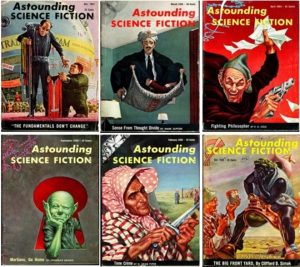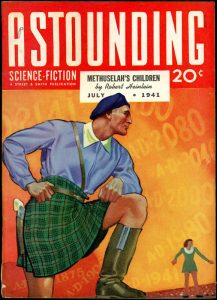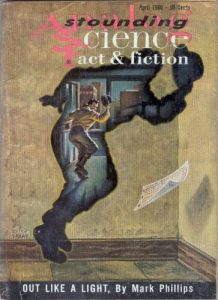 Next year will mark the 90th anniversary of Astounding Science Fiction, known these days as Analog. To mark the occasion, editor Trevor Quachri will be reprinting one story from each decade, starting with the 1940s and going through the 1990s. Anything later than the nineties, Quachri says, is too recent. More time will be needed to determine what the true classics will be. All right, I can go along with that, no problem.
Next year will mark the 90th anniversary of Astounding Science Fiction, known these days as Analog. To mark the occasion, editor Trevor Quachri will be reprinting one story from each decade, starting with the 1940s and going through the 1990s. Anything later than the nineties, Quachri says, is too recent. More time will be needed to determine what the true classics will be. All right, I can go along with that, no problem.
There will also be no stories reprinted from the 1930s. The reasoning here is that the identity hadn’t really formed yet. That sounds a lot like John Campbell hadn’t yet put his imprint on the magazine. Considering Quachri was in full support of changing the name of the Campbell Award earlier this year, I find this an interesting position to take. It’s his magazine, and he’s the editor, so I’m not going to make an issue of it. There are some writers from the Clayton days in the 30s who went on to have successful careers after Street & Smith took over the magazine, such as Clifford D. Simak, Jack Williamson, Edmond Hamilton, and Campbell himself.
 Since January is Vintage Science Fiction month, I’m going to do some posts here about the Clayton Astounding. I’m also going to review the stories Quachri (who is only the fifth editor of the magazine) and his team choose to reprint. Plus, I’ll look at both The Astounding Science Fiction Anthology (edited by Campbell) and the two volume Astounding-Analog Reader (edited by Harry Harrison and Brian W. Aldiss), which tended to focus on longer works that weren’t reprinted as often. These posts will probably look at a few stories at a time and continue throughout the year.
Since January is Vintage Science Fiction month, I’m going to do some posts here about the Clayton Astounding. I’m also going to review the stories Quachri (who is only the fifth editor of the magazine) and his team choose to reprint. Plus, I’ll look at both The Astounding Science Fiction Anthology (edited by Campbell) and the two volume Astounding-Analog Reader (edited by Harry Harrison and Brian W. Aldiss), which tended to focus on longer works that weren’t reprinted as often. These posts will probably look at a few stories at a time and continue throughout the year.
I’m also going to revive the Pre-Campbell SF Challenge I was doing last year. Much of that focus will be during vintage Science Fiction Month but will continue throughout the year.
 There have been hundreds of great stories published in Astounding/Analog over the decades, more than I’ve had a chance to read. I picked up a two CD set containing PDF’s of the entire run of Astounding earlier this year, and my collection of Analog is pretty complete to the mid-60’s. I may pick a few stories that aren’t very well known to look at.
There have been hundreds of great stories published in Astounding/Analog over the decades, more than I’ve had a chance to read. I picked up a two CD set containing PDF’s of the entire run of Astounding earlier this year, and my collection of Analog is pretty complete to the mid-60’s. I may pick a few stories that aren’t very well known to look at.
I’m also open to suggestions of stories to read. I am not promising I will get to any of them. But if there’s a favorite you’d like me to take a look at, I’ll see what I can do to fit it in. (But I make no promises in that regard.)

Much of the best of the “pre-Campbell” Astounding were novels, like The Legion of Space or the works of Doc Smith. If I were to pick a short from that decade, it might be Leinster’s “Sidewise In Time”.
And never forget that one of the best “pre-Campbell” authors was … John W. Campbell.
“Sidewise in Time” was great. And I completely agree that Campbell was one of the best pre-Campbell authors.
Speaking of Campbell, the “director’s cut” of “Who Goes There?” is now out in ebook and paper, Frozen Hell. It is about a third longer that the familiar version with most of the new stuff at the front. We now see the discovery and accidental; destruction of the alien spaceship. Supposedly this story was originally targeted for Argosy and appeared in Astounding only when that fell through.
I put “director’s cut” in quotes as Campbell was the one who prepared the familiar version for print, under instructions from his boss, Orlin Tremain. Still, he may have come to think the shorter version better as he did not bring out the longer version when the story collection of that name appeared in hardcover. An interesting variant to say the least.
Yeah, I have that. I just haven’t had a chance to read it yet.
One thing that was interesting about Frozen Hell in light of the later movie(s) is that the alien is referred to as “the Thing” with an uppercase letter. In WGT it is always lowercase. I wish I knew if this was in the manuscript or was a ‘fix’ by the current editor.
Interesting. Thanks for pointing that out.
I asked about the uppercase “Thing” on Alec Nevala-Lee’s website, and he replied that it is lowercase in the manuscript. He assumes hat the uppercase letter is the work of the editor, John Betancourt.
Thanks for following up on that.